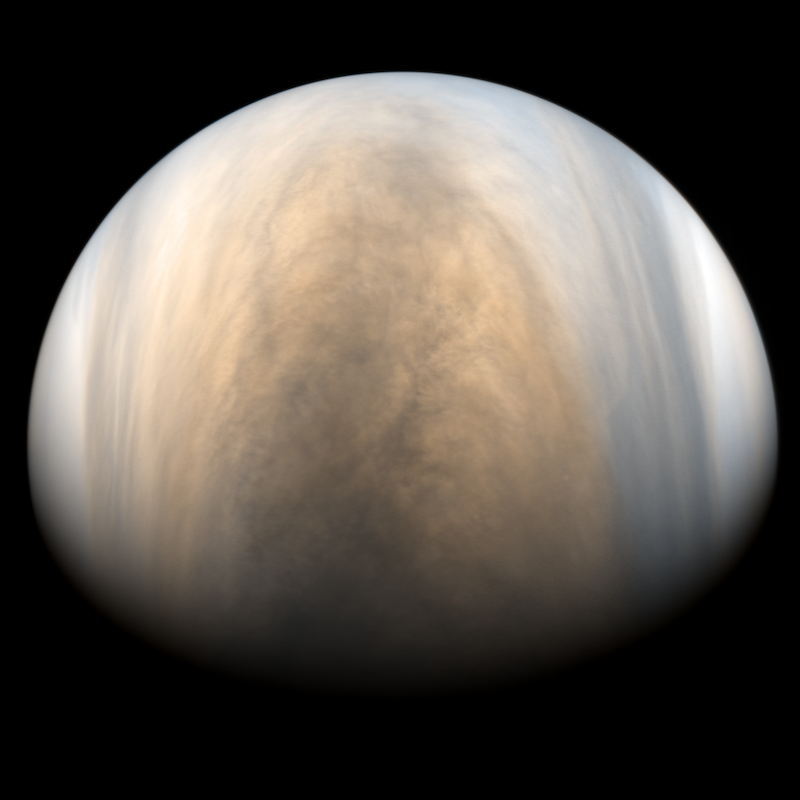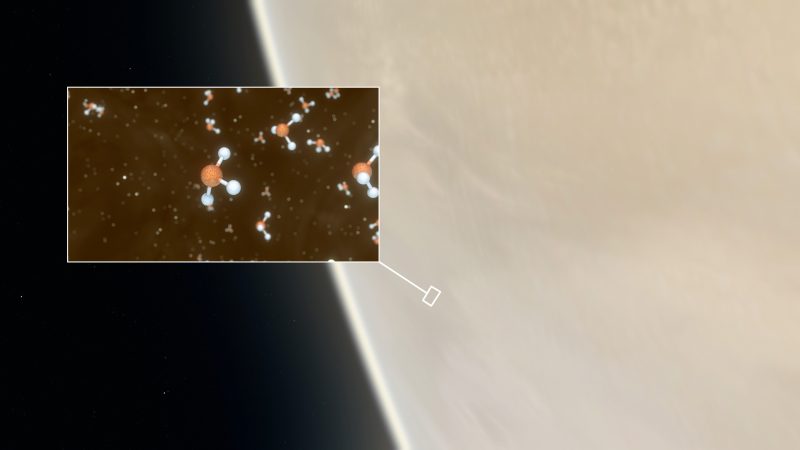2 research teams say they found more signs of phosphine on Venus. They also announced a tentative detection of ammonia: another possible biosignature gas.
The post Does phosphine on Venus mean … life? first appeared on EarthSky.

On Earth, phosphine is produced either by living microbes or artificially in labs. And, back in late 2020, scientists produced tantalizing evidence for phosphine in the dense clouds surrounding our neighboring planet, Venus. Since then, the finding has been fiercely debated. Some subsequent searches found it as well, but others didn’t. Now, new results have again upped the ante. On July 17, 2024, The Guardian reported on two research teams that have re-detected the phosphine, and have tentatively found ammonia as well. This is significant because, on Earth, ammonia is also produced by living microorganisms. It’s not proof that living microbes are floating around in Venus’ atmosphere. But it’s intriguing.
There aren’t any published papers yet – those are pending – but the researchers presented their preliminary findings at the National Astronomy Meeting in Hull, U.K., on July 17, 2024.
The first team focused on re-confirming the phosphine, if possible. Dave Clements, an astrophysicist at Imperial College London in the U.K., and his colleagues used the James Clerk Maxwell Telescope (JCMT) in Hawaii for the task. The observations were part of the JCMT-Venus project. The researchers detected the phosphine signature and were able to track it over time. This not only helped to re-confirm the presence of the phosphine itself, but also provided evidence that the gas follows the day-night cycle in the atmosphere. As Clements told The Guardian:
Our findings suggest that when the atmosphere is bathed in sunlight the phosphine is destroyed. All that we can say is that phosphine is there. We don’t know what’s producing it. It may be chemistry that we don’t understand. Or possibly life.
The detection also showed phosphine deeper in the atmosphere than previously known. The results are consistent with previous observations by NASA’s Pioneer Venus 2. Re-analysis of those results also hinted at phosphine at about 34 miles (55 km) altitude. Clements told IFLScience:
We haven’t properly sorted out the atmospheric modeling for this yet, but there are some broad lines at the level that suggest parts per million level of phosphine at around 55, 56 and 57-kilometer altitude, consistent with the Pioneer Venus probe data.
Interesting stuff from Dr Dave Clements of @imperialcollege in the #Venus session at #NAM2024.
He shares preliminary findings which "strengthen" evidence of phosphine in the planet's clouds, including detections of the potential biomarker deeper in a warmer area of the clouds. pic.twitter.com/MDqHDKoege
— Royal Astronomical Society (@RoyalAstroSoc) July 17, 2024
The second team, led by astronomer Jane Greaves at Cardiff University in the U.K., said they had tentatively detected ammonia in Venus’ atmosphere, using the Green Bank Telescope (GBO) in West Virginia. It was Greaves and her colleagues who first announced the phosphine discovery back in late 2020. On Earth, ammonia is typically produced by bacteria that convert nitrogen, or by industrial processes.
Like phosphine, scientists can make ammonia in labs, too. But it is considered to be a good biosignature, because – at least as far as we know – it’s not easily produced naturally on rocky planets. So if it were to be found in a rocky planet’s atmosphere, there is a good chance it comes from life.
And finding both phosphine and ammonia in Venus’ atmosphere is certainly even more interesting, if the findings are correct. It’s not proof of life on Venus, but it’s tantalizing. Ground truths are needed, via a return mission to Venus that would sample the atmosphere directly. As Greaves said:
Even if we confirmed both of these [findings], it is not evidence that we have found these magic microbes and they’re living there today.
Some scientists have speculated that microbes in Venus’ atmosphere could use ammonia to neutralize the harsh sulfuric acid droplets in the clouds. Greaves commented on this also, saying:
If there are any microbes in the Venus clouds, they might make certain gases that you wouldn’t expect. And ammonia came up, as they could use it as a way to neutralize the acid. We’ve detected it slightly above the region which we think is warm enough for life. Either it hasn’t got anything to do with life or the gas is perhaps produced by something living but it drifts upwards where it’s a bit easier for us to detect.
The ammonia detection is still tentative, so more observations are needed to fully confirm it, or not.
The Venus session gets even more exciting! @jgreaves6 from Cardiff University reveals that as well as phosphine, a second potential biomarker gas – ammonia – has been tentatively detected in the clouds of Venus.
Again, it's important to stress these are preliminary findings. pic.twitter.com/pxptIkTzxF
— Royal Astronomical Society (@RoyalAstroSoc) July 17, 2024
So are these really biosignatures, or can other exotic chemistry explain them? If both phosphine and ammonia can be confirmed, that would raise the chances of a biological explanation.
Nikku Madhusudhan is an astrophysicist at the University of Cambridge in the U.K. While not involved in the studies, he did offer his opinion, saying:
When it comes to Venus, both of those are open questions. If they really confirm phosphine and ammonia robustly it raises the chances of biological origin. The natural next thing will be new people will look at it and give support or counter-arguments. The story will be resolved by more data. All of this is grounds for optimism. If they can demonstrate the signals are there, good for them.
Robert Massey, the deputy executive director at the Royal Astronomical Society, added:
These are very exciting findings but it must be stressed that the results are only preliminary and more work is needed to learn more about the presence of these two potential biomarkers in Venus’ clouds. Nevertheless, it is fascinating to think that these detections could point to either possible signs of life or some unknown chemical processes. It will be interesting to see what further investigations unearth over the coming months and years.

Venus’ surface is extremely hostile to even the simplest forms of life. Temperatures reach a scorching 840 degrees Fahrenheit (450 C) and the air pressure is about 90 times that at Earth’s surface. Nevertheless, some scientists have long thought that microbes might be able to survive higher up in the atmosphere, most ideally at around 31 miles (50 km) altitude. There, conditions are much more Earth-like and comfortable. That’s quite close to the altitudes where the researchers detected more phosphine. But again, it’s too early to make conclusions.
Learning more about the sources of the phosphine and ammonia will require additional observations. The researchers plan to perform those using multiple telescopes. In addition, the privately designed and funded Rocket Lab Probe is scheduled to go to Venus in January 2025. It will conduct detailed, in-situ analysis of Venus’ atmosphere. It is designed specifically to look for organic molecules and other possible biological traces in the atmosphere of Venus.
Later, NASA’s DAVINCI mission will launch to Venus before the end of this decade. It will also focus on studying Venus’ atmosphere. The European Space Agency’s Envision mission will also go to Venus in the early 2030s. It will focus on the geology of the planet itself, but also analyze the atmosphere to look for trace gases.
Another study earlier this year also showed that amino acids – the building blocks of proteins – could survive in Venus’ atmosphere as well.
Bottom line: Two research teams say they found more signs of phosphine on Venus. They also announced a tentative detection of ammonia: another possible biosignature gas.
Read more: Amino acids on Venus? New study says it’s possible
Read more: The detection of phosphine in Venus’ clouds is a big deal
The post Does phosphine on Venus mean … life? first appeared on EarthSky.